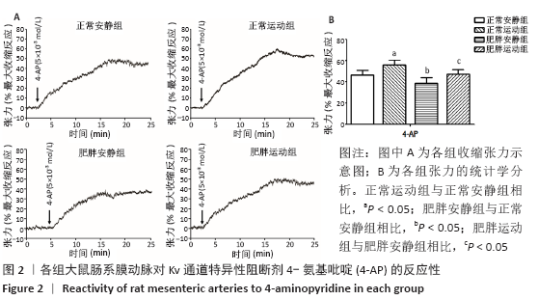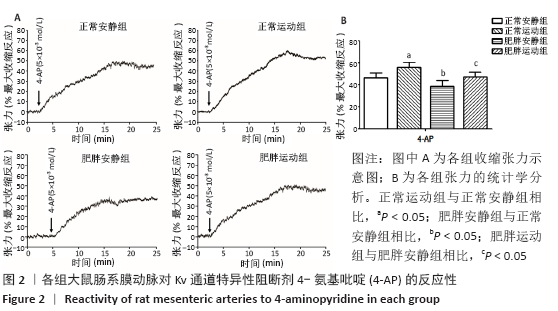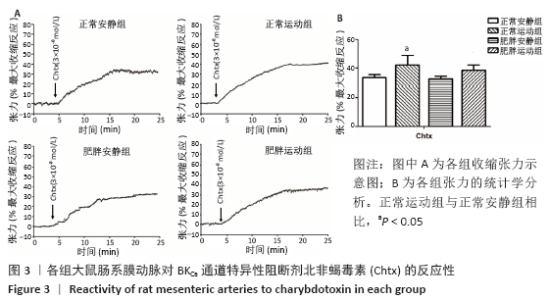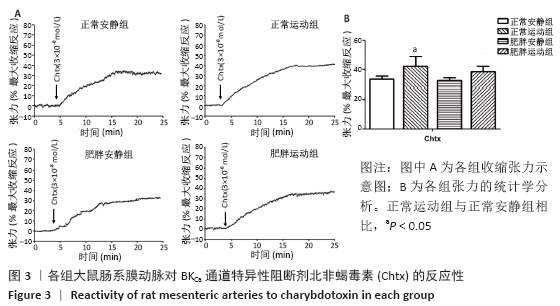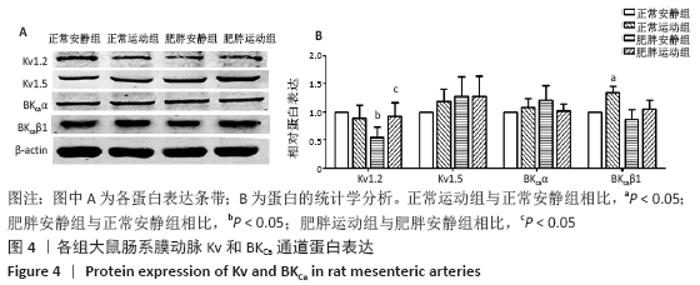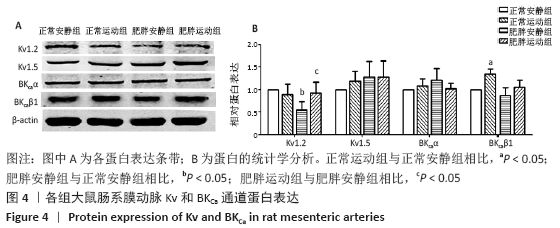Chinese Journal of Tissue Engineering Research ›› 2021, Vol. 25 ›› Issue (17): 2630-2635.doi: 10.3969/j.issn.2095-4344.3190
Previous Articles Next Articles
An 8-week aerobic exercise promotes the function of voltage-dependent potassium channel in mesenteric vascular smooth muscle from obese rats
Li Zihan, Yin Wen, Sun Wei, Zhu Kun, Shen Di, Liu Yujia
- School of Physical Education, Jiangsu Normal University, Xuzhou 221116, Jiangsu Province, China
-
Received:2020-04-21Revised:2020-04-24Accepted:2020-05-27Online:2021-06-18Published:2021-01-07 -
Contact:Liu Yujia, MD, Lecturer, School of Physical Education, Jiangsu Normal University, Xuzhou 221116, Jiangsu Province, China -
About author:Li Zihan, School of Physical Education, Jiangsu Normal University, Xuzhou 221116, Jiangsu Province, China -
Supported by:the Natural Science Foundation of Jiangsu Province, No. BK20190999 (to LYJ); the Natural Science Foundation of Jiangsu Provincial Universities, No. 18KJB180003 (to LYJ); Jiangsu University Students' Innovation and Entrepreneurship General Project, No. 201910320142Y (to LZH)
CLC Number:
Cite this article
Li Zihan, Yin Wen, Sun Wei, Zhu Kun, Shen Di, Liu Yujia. An 8-week aerobic exercise promotes the function of voltage-dependent potassium channel in mesenteric vascular smooth muscle from obese rats[J]. Chinese Journal of Tissue Engineering Research, 2021, 25(17): 2630-2635.
share this article

2.1 实验动物数量分析 实验开始采用60只大鼠用于构建模型,筛选得到20只肥胖大鼠,有20只未达到肥胖标准被舍去,最终共有40只大鼠进入结果分析,中途无脱落。 2.2 各组大鼠体质量、空腹血糖和血脂水平 在运动干预前,肥胖大鼠体质量显著高于普通大鼠(P < 0.05),而同一模型中的运动组与安静组间差异无显著性意义(P > 0.05)。如表1所示,肥胖安静组体质量、心脏质量、空腹血糖、三酰甘油、低密度脂蛋白和总胆固醇水平非常显著高于正常安静组(P < 0.01),而与正常安静组相比,正常运动组三酰甘油和低密度脂蛋白水平非常显著降低(P < 0.01);肥胖运动组体质量、心脏质量、空腹血糖、三酰甘油和低密度脂蛋白水平较肥胖安静组非常显著降低(P < 0.01)。 "

| [1] HANSEN AR, RUSTIN C, OPOKU ST, et al. Trends in US adults with overweight and obesity reporting being notified by doctors about body weight status, 1999-2016. Nutr Metab Cardiovasc Dis. 2020;30(4):608-615. [2] SERAVALLE G, GRASSI G. Obesity and hypertension. Pharmacol Res. 2017;122:1-7. [3] VECCHIÉ A, DALLEGRI F, CARBONE F, et al. Obesity phenotypes and their paradoxical association with cardiovascular diseases. Eur J Intern Med. 2018;48:6-17. [4] FOX CS, COADY S, SORLIE PD, et al. Increasing cardiovascular disease burden due to diabetes mellitus: the Framingham Heart Study. Circulation. 2007;115(12):1544-1550. [5] DAVEL AP, WENCESLAU CF, AKAMINE EH, et al. Endothelial dysfunction in cardiovascular and endocrine-metabolic diseases: an update. Braz J Med Biol Res. 2011;44(9):920-932. [6] CABALLERO AE. Endothelial dysfunction in obesity and insulin resistance: a road to diabetes and heart disease. Obes Res. 2003;11(11):1278-1289. [7] HAMDY O, LEDBURY S, MULLOOLY C,et al. Lifestyle modification improves endothelial function in obese subjects with the insulin resistance syndrome. Diabetes Care. 2003;26(7):2119-2125. [8] BRIONES AM, ARAS-LÓPEZ R, ALONSO MJ, et al. Small artery remodeling in obesity and insulin resistance. Curr Vasc Pharmacol. 2014;12(3):427-437. [9] ZWEIER JL, ILANGOVAN G. Regulation of Nitric Oxide Metabolism and Vascular Tone by Cytoglobin. Antioxid Redox Signal. 2020;32(16):1172-1187. [10] ZHU Y, YE P, CHEN SL, et al. Functional regulation of large conductance Ca(2+)-activated K(+) channels in vascular diseases. Metabolism. 2018;83:75-80. [11] NIEVES-CINTRÓN M, SYED AU, NYSTORIAK MA, et al. Regulation of voltage-gated potassium channels in vascular smooth muscle during hypertension and metabolic disorders. Microcirculation. 2018;25(1):1-17. [12] 郭艳军,刘菁菁,万晗星,等. Kv1.1及Kv1.3通道亚型对小鼠肠系膜微细动脉的调节作用[J].第三军医大学学报,2018,40(3):190-197. [13] BERWICK ZC, DICK GM, MOBERLY SP, et al. Contribution of voltage-dependent K⁺ channels to metabolic control of coronary blood flow. J Mol Cell Cardiol. 2012;52(4):912-919. [14] FRISBEE JC, MAIER KG, STEPP DW. Oxidant stress-induced increase in myogenic activation of skeletal muscle resistance arteries in obese Zucker rats. Am J Physiol Heart Circ Physiol. 2002;283(6):H2160-2168. [15] LU T, YE D, HE T, et al. Impaired Ca2+-dependent activation of large-conductance Ca2+-activated K+ channels in the coronary artery smooth muscle cells of Zucker Diabetic Fatty rats. Biophys J. 2008;95(11):5165-5177. [16] LOPEZ-NAVA G, ASOKKUMAR R, LACRUZ T, et al. The effect of weight loss and exercise on Health-Related Quality of Life (HRQOL) following Endoscopic Bariatric Therapies (EBT) for obesity. Health Qual Life Outcomes. 2020;18(1):130. [17] SAID MA, ABDELMONEEM M, ALIBRAHIM MC, et al. Effects of diet versus diet plus aerobic and resistance exercise on metabolic syndrome in obese young men. J Exerc Sci Fit. 2020;18(3):101-108. [18] RAMÍREZ-VÉLEZ R, CASTRO-ASTUDILLO K, CORREA-BAUTISTA JE, et al. The Effect of 12 Weeks of Different Exercise Training Modalities or Nutritional Guidance on Cardiometabolic Risk Factors, Vascular Parameters, and Physical Fitness in Overweight Adults: Cardiometabolic High-Intensity Interval Training-Resistance Training Randomized Controlled Study.J Strength Cond Res. 2020 Mar 12. doi: 10.1519/JSC.0000000000003533. Online ahead of print. [19] 房华玉,徐建方,王晓静,等.大强度间歇运动对肥胖大鼠骨骼肌AMPK/PGC-1α通路的影响[J].中国运动医学杂志,2020,39(2):124-132. [20] ZHANG Y, CHEN Y, XU Z, et al. Chronic exercise mediates epigenetic suppression of L-type Ca2+ channel and BKCa channel in mesenteric arteries of hypertensive rats. J Hypertens. 2020 May 7. doi: 10.1097/HJH.0000000000002457. Online ahead of print. [21] MARCHIO P, GUERRA-OJEDA S, VILA JM, et al. Chronic exercise impairs nitric oxide pathway in rabbit carotid and femoral arteries. J Physiol. 2018;596(18):4361-4374. [22] LI N, LIU B, XIANG S,et al. Similar enhancement of BK(Ca) channel function despite different aerobic exercise frequency in aging cerebrovascular myocytes. Physiol Res. 2016;65(3):447-459. [23] 朱磊,路瑛丽,冯连世,等.不同配方高脂饲料构建SD大鼠肥胖模型的实验研究[J].中国运动医学杂志,2016,35(7):642-647. [24] GAREKANI ET, MOHEBBI H, KRAEMER RR, et al. Exercise training intensity/volume affects plasma and tissue adiponectin concentrations in the male rat. Peptides. 2011;32(5):1008-1012. [25] BHATTA A, YAO L, XU Z, et al. Obesity-induced vascular dysfunction and arterial stiffening requires endothelial cell arginase 1. Cardiovasc Res. 2017;113(13): 1664-1676. [26] KURIYAMA H, KITAMURA K, NABATA H. Pharmacological and physiological significance of ion channels and factors that modulate them in vascular tissues. Pharmacol Rev. 1995;47(3):387-573. [27] YANG Y, JONES AW, THOMAS TR, et al. Influence of sex, high-fat diet, and exercise training on potassium currents of swine coronary smooth muscle. Am J Physiol Heart Circ Physiol. 2007;293(3):H1553-1563. [28] KO EA, PARK WS, FIRTH AL, et al. Increased sensitivity of serotonin on the voltage-dependent K+ channels in mesenteric arterial smooth muscle cells of OLETF rats. Prog Biophys Mol Biol. 2010;103(1):88-94. [29] HEAPS CL, JEFFERY EC, LAINE GA, et al. Effects of exercise training and hypercholesterolemia on adenosine activation of voltage-dependent K+ channels in coronary arterioles. J Appl Physiol (1985). 2008;105(6):1761-1771. [30] LI Z, LU N, SHI L. Exercise training reverses alterations in Kv and BKCa channel molecular expression in thoracic aorta smooth muscle cells from spontaneously hypertensive rats. J Vasc Res. 2014;51(6):447-457. [31] NELSON MT, QUAYLE JM. Physiological roles and properties of potassium channels in arterial smooth muscle. Am J Physiol. 1995;268(4 Pt 1):C799-822. [32] SZADO T, MCLARNON M, WANG X, et al. Role of sarcoplasmic reticulum in regulation of tonic contraction of rabbit basilar artery. Am J Physiol Heart Circ Physiol. 2001;281(4):H1481-1489. [33] RUSCH NJ. BK channels in cardiovascular disease: a complex story of channel dysregulation. Am J Physiol Heart Circ Physiol. 2009;297(5):H1580-1582. [34] BORBOUSE L, DICK GM, ASANO S, et al. Impaired function of coronary BK(Ca) channels in metabolic syndrome. Am J Physiol Heart Circ Physiol. 2009;297(5): H1629-1637. [35] BORBOUSE L, DICK GM, PAYNE GA, et al. Contribution of BK(Ca) channels to local metabolic coronary vasodilation: Effects of metabolic syndrome. Am J Physiol Heart Circ Physiol. 2010;298(3):H966-973. [36] OZKOR MA, MURROW JR, RAHMAN AM, et al. Endothelium-derived hyperpolarizing factor determines resting and stimulated forearm vasodilator tone in health and in disease. Circulation. 2011;123(20):2244-2253. [37] NYSTORIAK MA, NIEVES-CINTRÓN M, NYGREN PJ, et al. AKAP150 contributes to enhanced vascular tone by facilitating large-conductance Ca2+-activated K+ channel remodeling in hyperglycemia and diabetes mellitus. Circ Res. 2014; 114(4):607-615. [38] CLIMENT B, SÁNCHEZ A, MORENO L, et al. Underlying mechanisms preserving coronary basal tone and NO-mediated relaxation in obesity: Involvement of β1 subunit-mediated upregulation of BKCa channels. Atherosclerosis. 2017;263:227-236. [39] LI N, SHI Y, SHI L, et al. Effects of aerobic exercise training on large-conductance Ca(2+)-activated K (+) channels in rat cerebral artery smooth muscle cells. Eur J Appl Physiol. 2013;113(10):2553-2563. [40] CHEN SJ, WU CC, YEN MH. Exercise training activates large-conductance calcium-activated K(+) channels and enhances nitric oxide production in rat mesenteric artery and thoracic aorta. J Biomed Sci. 2001;8(3):248-255. [41] 李珊珊. 运动诱导大鼠心血管和胸主动脉平滑肌细胞功能重塑[D]. 北京:北京体育大学, 2011. [42] SHI L, ZHANG Y, LIU Y, et al. Exercise Prevents Upregulation of RyRs-BKCa Coupling in Cerebral Arterial Smooth Muscle Cells From Spontaneously Hypertensive Rats. Arterioscler Thromb Vasc Biol. 2016;36(8):1607-1617. [43] 刘晓东.有氧运动对衰老大鼠心血管功能和肠系膜动脉反应性的影响[D].北京: 北京体育大学, 2013. |
| [1] | Zhang Chong, Liu Zhiang, Yao Shuaihui, Gao Junsheng, Jiang Yan, Zhang Lu. Safety and effectiveness of topical application of tranexamic acid to reduce drainage of elderly femoral neck fractures after total hip arthroplasty [J]. Chinese Journal of Tissue Engineering Research, 2021, 25(9): 1381-1386. |
| [2] | Wang Haiying, Lü Bing, Li Hui, Wang Shunyi. Posterior lumbar interbody fusion for degenerative lumbar spondylolisthesis: prediction of functional prognosis of patients based on spinopelvic parameters [J]. Chinese Journal of Tissue Engineering Research, 2021, 25(9): 1393-1397. |
| [3] | Chen Jinping, Li Kui, Chen Qian, Guo Haoran, Zhang Yingbo, Wei Peng. Meta-analysis of the efficacy and safety of tranexamic acid in open spinal surgery [J]. Chinese Journal of Tissue Engineering Research, 2021, 25(9): 1458-1464. |
| [4] | Shu Wenbo, Chen Mengchi, Li Hua, Huang Liqian, Huang Binbin, Zhang Wenhai, Wu Yachen, Wang Zefeng, Li Qiaoli, Liu Peng. Correlation between body fat distribution and characteristics of daily physical activity in college students [J]. Chinese Journal of Tissue Engineering Research, 2021, 25(8): 1277-1283. |
| [5] | Ji Zhixiang, Lan Changgong. Polymorphism of urate transporter in gout and its correlation with gout treatment [J]. Chinese Journal of Tissue Engineering Research, 2021, 25(8): 1290-1298. |
| [6] | Wu Xun, Meng Juanhong, Zhang Jianyun, Wang Liang. Concentrated growth factors in the repair of a full-thickness condylar cartilage defect in a rabbit [J]. Chinese Journal of Tissue Engineering Research, 2021, 25(8): 1166-1171. |
| [7] | Shen Jinbo, Zhang Lin. Micro-injury of the Achilles tendon caused by acute exhaustive exercise in rats: ultrastructural changes and mechanism [J]. Chinese Journal of Tissue Engineering Research, 2021, 25(8): 1190-1195. |
| [8] | Zeng Zhen, Hu Jingwei, Li Xuan, Tang Linmei, Huang Zhiqiang, Li Mingxing. Quantitative analysis of renal blood flow perfusion using contrast-enhanced ultrasound in rats with hemorrhagic shock during resuscitation [J]. Chinese Journal of Tissue Engineering Research, 2021, 25(8): 1201-1206. |
| [9] | Tang Hui, Yao Zhihao, Luo Daowen, Peng Shuanglin, Yang Shuanglin, Wang Lang, Xiao Jingang. High fat and high sugar diet combined with streptozotocin to establish a rat model of type 2 diabetic osteoporosis [J]. Chinese Journal of Tissue Engineering Research, 2021, 25(8): 1207-1211. |
| [10] | Chai Le, Lü Jianlan, Hu Jintao, Hu Huahui, Xu Qingjun, Yu Jinwei, Quan Renfu. Signal pathway variation after induction of inflammatory response in rats with acute spinal cord injury [J]. Chinese Journal of Tissue Engineering Research, 2021, 25(8): 1218-1223. |
| [11] | Liu Xiangxiang, Huang Yunmei, Chen Wenlie, Lin Ruhui, Lu Xiaodong, Li Zuanfang, Xu Yaye, Huang Meiya, Li Xihai. Ultrastructural changes of the white zone cells of the meniscus in a rat model of early osteoarthritis [J]. Chinese Journal of Tissue Engineering Research, 2021, 25(8): 1237-1242. |
| [12] | Liu Cong, Liu Su. Molecular mechanism of miR-17-5p regulation of hypoxia inducible factor-1α mediated adipocyte differentiation and angiogenesis [J]. Chinese Journal of Tissue Engineering Research, 2021, 25(7): 1069-1074. |
| [13] | Wang Zhengdong, Huang Na, Chen Jingxian, Zheng Zuobing, Hu Xinyu, Li Mei, Su Xiao, Su Xuesen, Yan Nan. Inhibitory effects of sodium butyrate on microglial activation and expression of inflammatory factors induced by fluorosis [J]. Chinese Journal of Tissue Engineering Research, 2021, 25(7): 1075-1080. |
| [14] | Wan Ran, Shi Xu, Liu Jingsong, Wang Yansong. Research progress in the treatment of spinal cord injury with mesenchymal stem cell secretome [J]. Chinese Journal of Tissue Engineering Research, 2021, 25(7): 1088-1095. |
| [15] | Xie Wenjia, Xia Tianjiao, Zhou Qingyun, Liu Yujia, Gu Xiaoping. Role of microglia-mediated neuronal injury in neurodegenerative diseases [J]. Chinese Journal of Tissue Engineering Research, 2021, 25(7): 1109-1115. |
| Viewed | ||||||
|
Full text |
|
|||||
|
Abstract |
|
|||||


